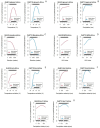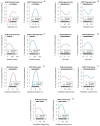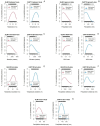Influence of environmental, geographic, socio-demographic, and epidemiological factors on presence of malaria at the community level in two continents
- PMID: 39030306
- PMCID: PMC11271557
- DOI: 10.1038/s41598-024-67452-5
Influence of environmental, geographic, socio-demographic, and epidemiological factors on presence of malaria at the community level in two continents
Abstract
The interactions of environmental, geographic, socio-demographic, and epidemiological factors in shaping mosquito-borne disease transmission dynamics are complex and changeable, influencing the abundance and distribution of vectors and the pathogens they transmit. In this study, 27 years of cross-sectional malaria survey data (1990-2017) were used to examine the effects of these factors on Plasmodium falciparum and Plasmodium vivax malaria presence at the community level in Africa and Asia. Monthly long-term, open-source data for each factor were compiled and analyzed using generalized linear models and classification and regression trees. Both temperature and precipitation exhibited unimodal relationships with malaria, with a positive effect up to a point after which a negative effect was observed as temperature and precipitation increased. Overall decline in malaria from 2000 to 2012 was well captured by the models, as was the resurgence after that. The models also indicated higher malaria in regions with lower economic and development indicators. Malaria is driven by a combination of environmental, geographic, socioeconomic, and epidemiological factors, and in this study, we demonstrated two approaches to capturing this complexity of drivers within models. Identifying these key drivers, and describing their associations with malaria, provides key information to inform planning and prevention strategies and interventions to reduce malaria burden.
Keywords: Plasmodium falciparum; Plasmodium vivax; Africa; Asia; Bioclimatic variables; Malaria; Malaria survey data; Temperature; Vector-borne diseases.
© 2024. The Author(s).
Conflict of interest statement
The authors declare no competing interests.
Figures






Similar articles
-
Five years following first detection of Anopheles stephensi (Diptera: Culicidae) in Djibouti, Horn of Africa: populations established-malaria emerging.Parasitol Res. 2019 Mar;118(3):725-732. doi: 10.1007/s00436-019-06213-0. Epub 2019 Jan 22. Parasitol Res. 2019. PMID: 30671729
-
Temperature impacts the environmental suitability for malaria transmission by Anopheles gambiae and Anopheles stephensi.Ecology. 2022 Aug;103(8):e3685. doi: 10.1002/ecy.3685. Epub 2022 Jun 14. Ecology. 2022. PMID: 35315521 Free PMC article.
-
Malaria resurgence risk in southern Europe: climate assessment in an historically endemic area of rice fields at the Mediterranean shore of Spain.Malar J. 2010 Jul 31;9:221. doi: 10.1186/1475-2875-9-221. Malar J. 2010. PMID: 20673367 Free PMC article.
-
Out of Africa: origins and evolution of the human malaria parasites Plasmodium falciparum and Plasmodium vivax.Int J Parasitol. 2017 Feb;47(2-3):87-97. doi: 10.1016/j.ijpara.2016.05.008. Epub 2016 Jul 2. Int J Parasitol. 2017. PMID: 27381764 Free PMC article. Review.
-
[Role of primaquine in malaria control and elimination in French-speaking Africa].Bull Soc Pathol Exot. 2017 Aug;110(3):198-206. doi: 10.1007/s13149-017-0556-z. Epub 2017 Apr 17. Bull Soc Pathol Exot. 2017. PMID: 28417346 Review. French.
References
-
- World Health Organization. World malaria report 2023. WHO Geneva. Technical report at https://www.who.int/publications/i/item/9789240086173 (2023).
-
- World Health Organization. World malaria report 2019. WHO Geneva. Technical report at https://www.who.int/publications/i/item/world-malaria-report-2019 (2019).
-
- James, S. L. et al. Global, regional, and national incidence, prevalence, and years lived with disability for 354 diseases and injuries for 195 countries and territories, 1990–2017: a systematic analysis for the Global Burden of Disease Study 2017. The Lancet392, 1789–1858 (2018).10.1016/S0140-6736(18)32279-7 - DOI - PMC - PubMed
-
- World Health Organization. World malaria report 2022. WHO Geneva. Technical report at https://www.who.int/teams/global-malaria-programme/reports/world-malaria... (2022).
MeSH terms
Grants and funding
LinkOut - more resources
Full Text Sources

